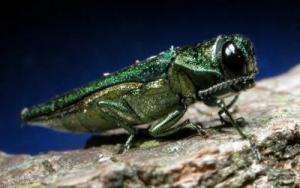Nature might be able to provide a partial solution, at least, to emerald ash borer problems in national parks such as Shenandoah and Great Smoky Mountains as well as Sleeping Bear Dunes National Lakeshore. It turns out that woodpeckers and nuthatches, which are present in those parks, are developing an appetite for the non-native insects.
Studies in Ohio and Michigan concluded that those two bird species have added the insects to their diets. That news could be welcomed in units of the National Park System where the insect poses a threat to forests.
"We found we have a native predator that is able to detect and respond to this new rich food resource," said Charles Flower, a postdoctoral research associate in biology at the University of Illinois at Chicago who was the first author of the study.
The findings were first reported in the online journal Forest Ecology and Management.
The emerald ash borer was first found feeding on trees in southeastern Michigan in 2002. Since then this Asian invader has been responsible for the death of 30 million trees in the northeastern U.S. and Canada, according to researchers at the University of Illinois at Chicago. The insect was spotted at Sleeping Bear Dunes in 2011, at Great Smoky Mountains in 2012, and in Shenandoah earlier this year.
The emerald ash borer is a half-inch-long metallic green beetle that lays its eggs on the bark of ash trees. After hatching, larvae burrow under the bark, creating feeding tunnels that cut off nutrients and water flow to the tree. Trees typically die within three to five years of being infected.
In a study in Ohio that utilized the help of middle school students to actually inspect trees to see whether woodpeckers were eating emerald ash borers.
A section of trees in the stand behind the school was cut down for examination each year for two years. The students searched for and painted all the holes they found in the bark of each tree—a different color each for large round woodpecker holes, for the characteristic crescent-shaped holes mature emerald ash borers make exiting a tree and for holes made by other insects.
Paint seeped through to dye the stem beneath, and after the bark was stripped the students could identify woodpecker holes that penetrated into emerald ash borer galleries, or into holes made by other bugs. The students tracked the fate of each bug that had been in the tree. Instead of relying on a statistical estimate of the insect population and thus the food source available, every bug and its fate were accounted for.
"This was looking at woodpecker foraging at a fine tree-by-tree scale," said Flower. Their results proved that woodpeckers were indeed choosing to prey on emerald ash borers--eating 85 percent of the emerald ash borers in an infested tree.
A related study conducted by Cornell University researchers, while not tracking what birds ate, found that woodpecker and white-breasted nuthatch populations increased in areas of the Great Lakes where emerald ash borers turned up.
"With the numerical response they found and the functional response we found, we have really powerful evidence of the potential of the woodpeckers and the nuthatch to have an impact on the population of the emerald ash borer," said Christopher Whelan, an avian ecologist with the Illinois Natural History Survey.
Sleeping Bear Dunes counts Northern flickers, Downy woodpeckers, and Hairy woodpeckers, as well as Red-breasted and White-breasted nuthatches as common residents in its forests. Both Red-breasted and White-breasted nuthatches, as well as Red-bellied, Downy, Hairy and Pileated woodpeckers, along with Northern flickers are common in Great Smoky. Shenandoah counts among its regulars Northern flickers, Downy, Hairy, and Red-bellied woodpeckers, as well as White-breasted nuthatches.


 Support Essential Coverage of Essential Places
Support Essential Coverage of Essential Places






